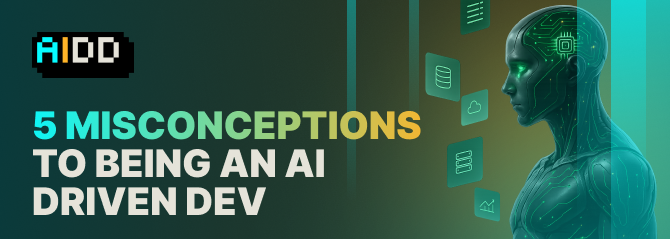
5 Misconceptions to being an AI Driven Dev
Charles Allotey •16 September 25
The rise of AI-powered development tools has transformed how we write, debug, and deploy code. From GitHub Copilot, Cursor, Claude Code to ChatGPT, these tools have become integral to many developers' workflows. However, this shift has also spawned numerous misconceptions about what it means to be an AI-driven developer. Let's debunk five of the most persistent myths and explore the reality of modern AI-assisted development.
Misconception #1: "AI Will Replace Developers Entirely"
Perhaps the most widespread fear in the developer community is that AI will make human programmers obsolete. This misconception stems from sensationalized headlines and a fundamental misunderstanding of what AI development tools actually do.
The Reality: AI tools are powerful assistants, not replacements. They excel at generating boilerplate code, suggesting completions, and helping with routine tasks, but they lack the critical thinking, domain expertise, and creative problem-solving abilities that define skilled developers. AI can't understand complex business requirements, make architectural decisions, or navigate the nuanced trade-offs that experienced developers handle daily.
Modern development involves much more than writing code – it requires understanding user needs, designing systems, managing technical debt, collaborating with teams, and making strategic technology choices. These human-centric skills remain irreplaceable.
Misconception #2: "Using AI Means You're Not a 'Real' Developer"
Some developers feel that relying on AI tools somehow diminishes their credibility or suggests they lack fundamental programming skills. This gatekeeping mentality treats AI assistance as "cheating" rather than leveraging available resources.
The Reality: Using AI tools is simply the evolution of developer productivity, similar to how IDEs, stack overflow, and open-source libraries became standard parts of the development process. The best developers have always been those who effectively use available tools to solve problems more efficiently.
An AI-driven developer isn't someone who blindly copies AI-generated code, but rather someone who knows how to effectively prompt AI systems, critically evaluate their output, and integrate AI assistance into a broader problem-solving strategy. This requires deep technical knowledge to guide the AI effectively and spot potential issues.
Misconception #3: "AI-Generated Code Is Always Correct and Secure"
Many developers new to AI tools assume that because the code looks syntactically correct and runs without immediate errors, it must be production-ready. This misconception has led to security vulnerabilities and technical debt in numerous projects.
The Reality: AI-generated code requires the same scrutiny as any other code – perhaps more. AI models can produce code that works for basic test cases but fails under edge conditions, introduces security vulnerabilities, or doesn't follow best practices. They may also generate code that's inefficient or doesn't align with your project's architectural patterns.
Successful AI-driven developers develop strong code review skills specifically for AI-generated content. They understand common AI pitfalls, know how to write effective prompts that include security and performance requirements, and always test thoroughly before deploying AI-assisted code.
Misconception #4: "You Don't Need to Understand the Code AI Generates"
Some developers treat AI tools as black boxes, copying and pasting generated code without understanding its functionality. This approach assumes that as long as the code works, comprehension is unnecessary.
The Reality: Understanding AI-generated code is crucial for long-term maintainability, debugging, and system evolution. When you don't understand the code in your system, you can't effectively modify it, debug issues, or ensure it integrates properly with other components.
Moreover, blindly using code you don't understand creates technical debt and makes your system fragile. When something breaks, you'll struggle to fix it. When requirements change, you won't know how to adapt the code. Effective AI-driven developers use AI to accelerate their work while maintaining deep understanding of their codebase.
Misconception #5: "AI Can Handle Any Programming Task Equally Well"
Many developers expect AI tools to be equally effective across all programming domains and complexity levels. This leads to frustration when AI struggles with certain types of tasks or produces poor results in specific contexts.
The Reality: AI tools have distinct strengths and weaknesses that vary by programming domain, language, and task complexity. They excel at common patterns, standard implementations, and well-documented use cases but struggle with novel algorithms, domain-specific optimizations, and complex system integrations.
AI typically performs better with popular programming languages and frameworks that have extensive training data. It's excellent for generating unit tests, creating REST API endpoints, and implementing standard data structures, but may struggle with specialized domains like embedded programming, performance-critical systems, or cutting-edge research implementations.
Smart AI-driven developers learn to recognize which tasks are good candidates for AI assistance and which require primarily human expertise. They develop intuition about when to rely on AI and when to code from scratch.
The Path Forward: Embracing AI-Driven Development
The future belongs to developers who can effectively collaborate with AI tools while maintaining their core engineering skills. This means:
Developing AI literacy: Understanding how different AI tools work, their limitations, and how to prompt them effectively
Maintaining technical depth: Continuing to build strong fundamentals in web development, computer science, software architecture, and domain expertise
Evolving workflow practices: Integrating AI tools into development processes in ways that enhance rather than replace critical thinking
Staying adaptable: As AI tools evolve rapidly, successful developers remain flexible and continue learning
Being an AI-driven developer isn't about replacing human skills with artificial intelligence – it's about augmenting human capabilities with powerful tools to solve problems more effectively. The developers who thrive in this new landscape will be those who embrace AI as a collaborative partner while maintaining the critical thinking, creativity, and domain expertise that define excellent engineering.
The key is finding the right balance: leveraging AI to handle routine tasks and accelerate development while preserving the human judgment, creativity, and deep technical understanding that remain essential to building great software.
Sign up to our AIDD masterclass and explore further how AI tools and your skills can work better together to make you a 100x developer.